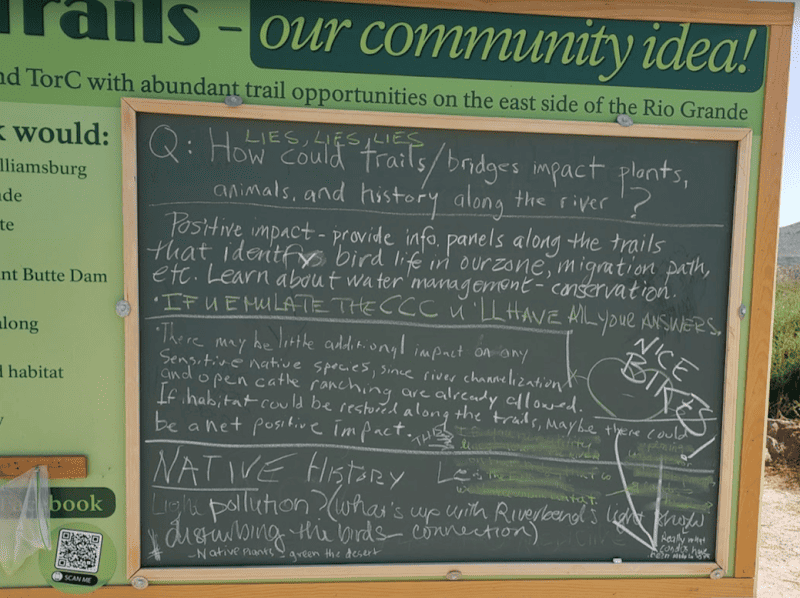Six months ago the T or C City Commission tabled the Turtleback Trails plan for fear its implementation would commit city staff time and city money and increase the city’s liability and responsibility for emergency and fire services across the river.
The other sticking point was the differing goals in the city’s “Riverwalk Feasibility Study” and the Turtleback Trails plan. The city helped the nascent coalition that eventually became the Turtleback Trails Network get a National Parks Service technical grant with the primary goal of building one or two foot bridges across the river. Then the city hired Wilson & Co. to do a study with the opposing goal of building a vehicle bridge that would also carry water and wastewater pipes across the river, paving the way for development and traffic and housing. The city commission approved the Riverwalk plan about two years ago, despite two meetings in which dozens of community members voiced disapproval of a vehicular bridge.
The city was supposed to bring the Turtleback Trails plan back with changes to mitigate its concerns, but didn’t. John Masterson, did, again seeking the plan’s approval, getting it put on the Sept. 27 city commission meeting agenda, and obviously doing a good job of getting the word out, because 16 people spoke in fervid favor of the plan, daring to speak at the mic in a mic-shy town.
Michael Hutchins spoke first, having served on the Turtleback Trails Steering Committee. He hilariously described how difficult it is to explain to those seeking outdoor fun how to get across the river, as did other speakers. Many expressed amazement that the city had done nothing to develop the area across the river as a nature-lovers’ tourist draw.
After the 16 spoke, Masterson spoke via phone, stating he could not be there because he has “covid.” He described himself as the “flag bearer” of the plan, as well he might. A runner, often crossing the river from its somewhat developed side to its mostly undeveloped side, he knew its delights and built a coalition of nature lovers. As the owner of the T or C Brewery and Sidekixx, he also knew what people wanted, both townies and tourists: outdoor recreation, that is, trails for running, hiking, walking, bike riding and bird watching, as well as launch points for non-motorized boating craft.
Masterson authored the information found on the city’s website that has the plan as well as a summary of the plan and its goals. It reveals who the “stakeholders” are and the intensive community-outreach efforts that were made. It even has links to summaries of steering committee meetings. https://www.torcnm.org/residents/new_page.php
Masterson wrote a guest column published in the Sierra County Sentinel in April, right after the city commission tabled the plan. He pointed out how it had been shopped and reviewed by many agencies and affected authorities that were all in favor of the plan: https://sierracountycitizen.org/stuff-you-need-to-know-4-24-23/
The latest version that finally received city commission approval only slightly tweaked the plan submitted last April. Instead of calling it a “master plan,” it’s now a “concept plan.” To get rid of any onus or obligation the city might have, a statement has been added that any implementation plan has to go before the city commission for approval.
Many of the speakers, including Masterson also pointed out that the plan is not “all or nothing,” and can be approached in phases, which assuaged anxiety about taking on the project.
As far as money is concerned, Masterson and others pointed out that grants for outdoor recreation have proliferated since covid, and “there is a ton of it out there.” Sixteen granting agencies are listed in the plan, “and there are many more,” Masterson said.
The city commission was lacking two of its five members at the meeting, Mayor Amanda Forrister and City Commissioner Shelly Harrelson, which probably aided in getting the plan approved.
Forrister insisted in April that “this is our plan and we need to take control of it.” She also asked Assistant City Manager Traci Alvarez what she thought. Alvarez said she had other recreational priorities, such as work on the city’s playing fields for the youth in the area. The vehicle bridge to get utilities across, as in the Riverwalk plan, was also a priority over a foot bridge, Alvarez said.
Forrister also argued that fellow-commissioner Merry Jo Fahl should not present or speak on the plan and should recuse herself from a vote on the plan, since she participated in its planning. Fahl was part of the Steering Committee and instrumental as the Sierra Soil and Water Conservation District manager (until she retired about two and a half years ago) in coordinating government agencies’ cooperation in giving input and guidance on the trail plan. Fahl, in a similar effort, was one of the leads in creating the city’s three-mile Healing Waters Trail 10 years ago. Fahl did not recuse herself in April, but did remain mum. At this week’s meeting, she said “inaccurate” and “negative” statements made last April were “heart rendering.”
Fahl pointed out that most of the trail will be on a county road, BLM land and a private person’s land, and that the city has little authority over what happens in the river, seemingly emphasizing that the trail will be not be primarily or just the city’s responsibility. She said the BLM portion will require a “NEPA process,” (National Environmental Protection Act) “which is a long process.” The private land owner, Fahl said, is amenable to giving some sort of easement to his land.
Fahl was the only one who addressed the vehicular vs. pedestrian bridge and people vs. vehicles conflicts in the Riverwalk and Turtleback plans, and only tangentially. “The foot bridges are not for UTVs,” Fahl said, and that “It’s a multi-use trail,” implying the UTVs will cross some other way.
Fahl, like other speakers, said the “economic boon will be incredible” once the trail is created.
Mayor Pro Tem Rolf Hechler said the city is experiencing “a resurgence” and in aid of this, “We should preserve our public land” as an attractant.
Hechler said the city could possibly pass an ordinance limiting boats to non-motorized boats.
Although other speakers said the city is already inviting people to float the river, that river access, marked and maintained trails and a foot bridge will reduce liability, Hechler did not discount that the city will need to respond to emergencies on and across the river. “Funding to train police and fire and rescue,” will need to be sought, he said.
Hechler, Fahl and City Commissioner Destiny Mitchell unanimously approved the Turtleback Plan.


Congrats all around! The birds, the coyotes, the roadrunners, the hikers, and all lovers of the Rio Grande thank everyone who worked so hard to bring the vision of Turtulback Trails this far. May it come to completion as envisioned!
Thank you, Rolf Hoechler, Mary Jo Fahl, and Destiny Mitchell for approving this plan. Future generations will thank you for it.
Thank you, Sierra County Citizen, for steadfastly reporting on and publicizing this effort.
Haruhuani Spruce, M.D.